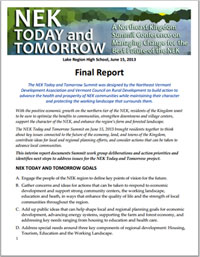
Over the last few months VCRD has been working with the Northeast Vermont Development Corporation to convene a dialogue in the Northeast Kingdom on “Managing Change for the Best Future of the NEK.” We facilitated the “NEK Today and Tomorrow Summit” at Lake Region High School on June 15th and have followed up with a conversation with NEK leadership on how best to advance the priorities of Summit participants.
You can find the ‘final’ report of the Summit here.
The Summit was designed to “build action to advance the health and prosperity of NEK communities while maintaining their character and protecting the working landscape that surrounds them.”
Clearly, the Kingdom is undergoing a rapid period of change with the dynamic economic development going forward at Jay Peak, Burke Mountain, Newport, and across the northern tier. While participants have expressed concerns on issues ranging from sprawl to traffic, the Summit and subsequent discussions have embraced the opportunity to plan for the future of the Kingdom.
 Bill Stenger set an emotional tone at the Summit when he said that the EB5-fueled developments beyond Jay Peak are not needed for his business plan. “It’s not about the money,” he said. He struck a chord when he spoke about the history of poverty and the need to provide opportunities that can stimulate the next generation to stay and use their skills in the NEK. Youth, jobs, and the community vitality that follows are the key ingredients that can make the best of the NEK in the future.
Bill Stenger set an emotional tone at the Summit when he said that the EB5-fueled developments beyond Jay Peak are not needed for his business plan. “It’s not about the money,” he said. He struck a chord when he spoke about the history of poverty and the need to provide opportunities that can stimulate the next generation to stay and use their skills in the NEK. Youth, jobs, and the community vitality that follows are the key ingredients that can make the best of the NEK in the future.
Working teams proposed ideas to address inevitable issues that connected to the new development, especially around housing, tourism, working lands, and education. Since there is so much great collaboration already going in these areas as well as good engaged leadership, much of the discussion concentrated on communicating what was happening and ensuring coordination.
In the end, the clear priority at the center of the discussions was around the essential part that the farm and forest environment of the Kingdom play in building the sense of place, the ‘brand’, and the foundation for the lifestyles of NEK residents. Summit participants and working group members identified key elements of work that should be done to advance working lands in the Northeast Kingdom. Supporting farm, forest and value-added enterprises is critically important to providing an economic foundation that keeps land in production—with all the associated benefits for views, recreation, ecological services and quality of life.
Several ideas are in process:
- Partners will work to communicate with and encourage developers to locally-source wood and other building materials, and to systematically connect to local foods in the future.
- A land ethic/working lands vision will be built into the regional planning process with broad public participation.
- Key stakeholders have committed to come together to consider ways to strengthen and expand investment in working lands enterprises: farms, forest operations and the full range of value-adding chains that provide an economic foundation for the future of working lands in the Kingdom. There is a strong interest in working to find and leverage new access to capital, including, potentially, the EB5 model, to support value-added food and forest product development, expand local markets for agricultural and forest products, and develop incubator spaces and infrastructure, both for production, but also to store and distribute local food products year round.
There’s so much more to the work beyond this brief summary and so many great ideas in the report—you should take a look!
It’s such an honor for us at VCRD to be able to be part of dialogues like this. There’s a lot we disagree about as Vermonters, and that’s natural, but there’s so much that we care about as a people. This is especially so, I think, in the Kingdom. People feel such a strong sense of identification with this special place — a real patriotism for the land and communities here — that provides a unity that underlies divisions and challenges, and can fuel the work needed for the future.
